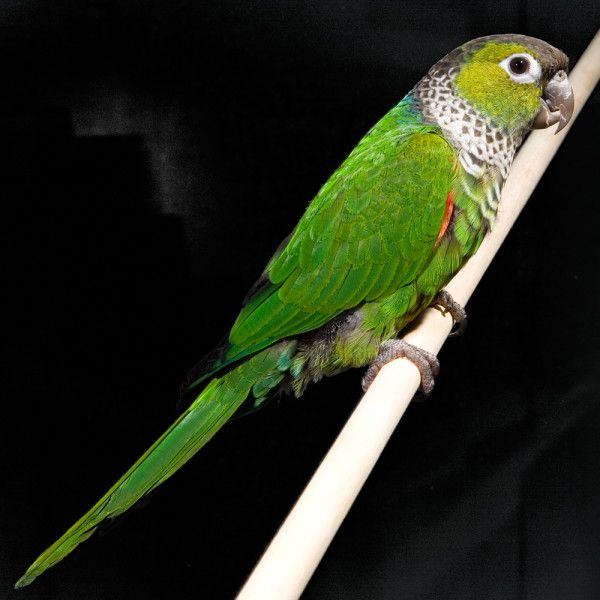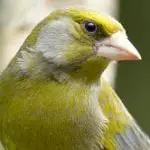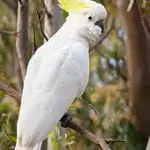Scientific Facts
| Common Name | Black-capped Conure |
| Scientific Name | Pyrrhura rupicola |
| Origin | Amazon Basin especially in the south-western parts together with the adjacent east Andean slopes in Bolivia, Peru, and Brazil |
| Habitat | Humid and lowland forest with an altitude of 1000 meters on the east Andean slopes |
| Diet | In the wild such as seeds from flowers, vegetables, fruits, and other crops. In captivity, their diet should consist of 75% pelleted mix and at least 25% fresh foods from fruits and vegetables |
| Size and Weight | 9 inches (24cm) with a weight of 2.5 ounces (70 grams |
| Lifespan | Wild: 10-15 years Captivity: 30 years |
Physical Description
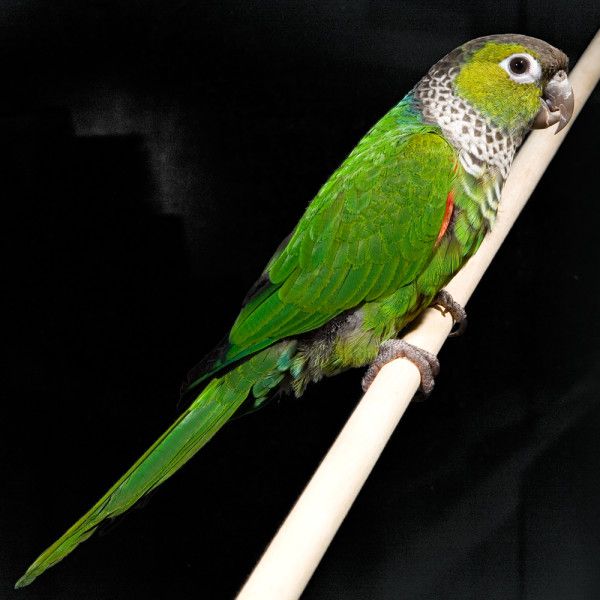
The black-capped parakeet (Pyrrhura rupicola) is also named as the black-capped conure or the rock conure. This conure species is known for the intricate details on its body that make them distinct. Their bodies are covered in a mostly deep green shade. As its name implies, its head, nape, and forehead are in color black with white eye-ring. One of the unique details in their body is the patterns of black and white seen on their collar and upper chest that resembles the looks of a scale.
The color of their cheeks is brownish-green with a black beak. The edges of their wings, as well as their abdomen, has bright red hints that add color to their green bodies as they fly. The tails are colored green with legs and undersides that are colored grey. The juveniles have the same physical attributes as the adults, but they have a duller feather coloration.
Where it is Seen?
It is a conure species that is native to the Amazon Basin, especially in the south-western parts together with the adjacent east Andean slopes in Bolivia, Peru, and Brazil.
Habitat
The black-capped conure lives in a humid and lowland forest with an altitude of 1000 meters on the east Andean slopes.
Behavior and Temperament
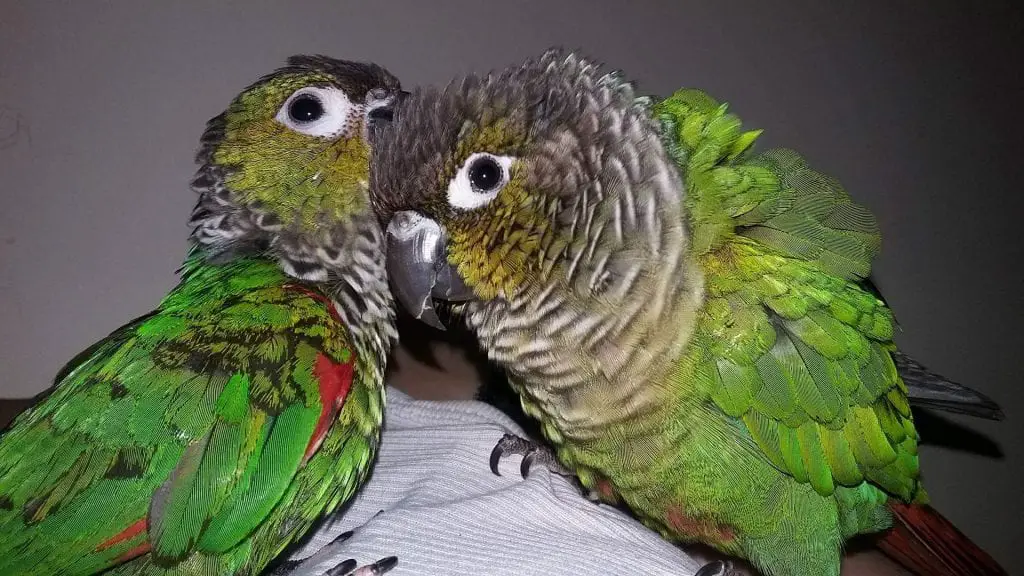
The black-capped conure is considered as the quietest conures, but they can be too loud during a call in the wild or when they are left alone and bored in captivity, expect that they squeaked at dawn like how the chicken does. They are social birds that tend to be more active at dawn and dusk. They do preening for them to be clean and is usually accompanied by a yawn to clear their nasal passages. In captivity, they enjoyed being petted by their owners through scratching of the different parts of their body.
Breeding and Reproduction
The black-capped conures attain their sexual maturity at around 18 months old, but the exact timing differs from one bird to another. The breeding season starts at the end of December for their eggs to be laid in February. The females incubate their 4-7 eggs for about 23-26 days before hatch. Both male and female black-caped conure feed their juveniles for about 8 or 9 weeks. There is no problem breeding in captivity as long as the cage where they are in is ideal for breeding. Before the breeding session, the females should be introduced to their nesting cage for them to be acclimated first before they are introduced to the male so that they are already comfortable where they are in.
Diet
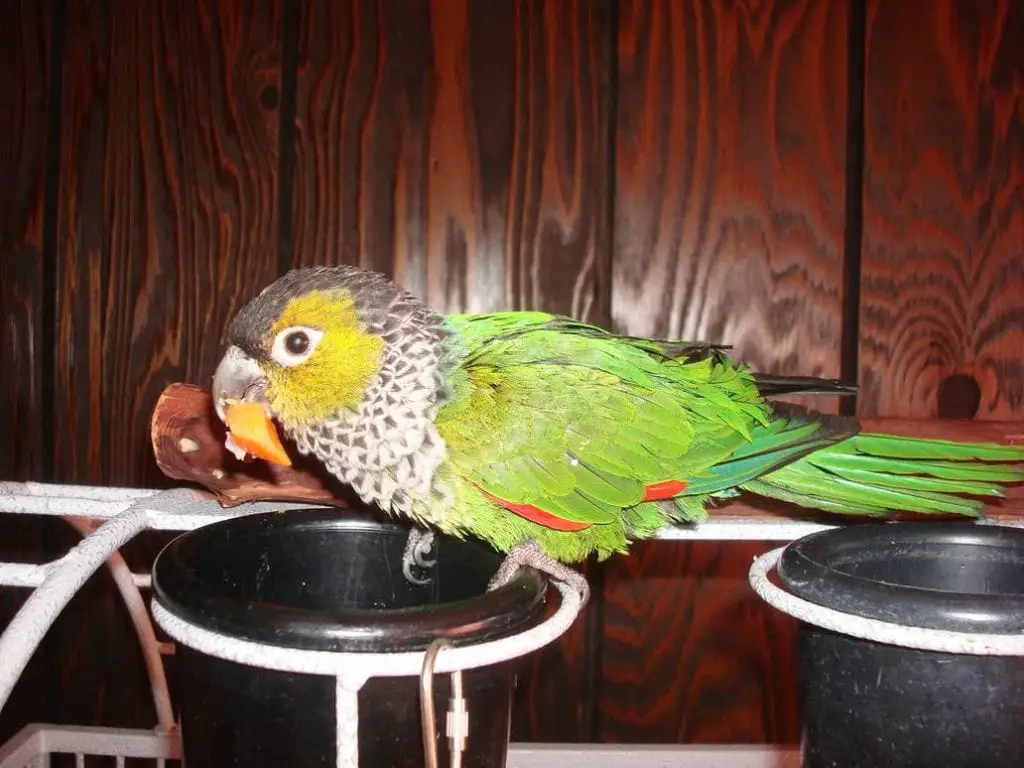
The black-capped conure’s diet consists of a wide variety of food that they can see in the wild such as seeds from flowers, vegetables, fruits, and other crops. In captivity, their diet should consist of 75% pelleted mix and at least 25% fresh foods from fruits and vegetables. Nuts and seeds should only be given to them in captivity as a treat only because these are high in fats that may lead them to be overweight, especially that they do not have too much exercise in their cage.
Size and Weight
The black-capped conure is a small type of conure species, but if you would consider their long tail, they can be considered as a medium-sized parrot that has a size of 9 inches (24cm) with a weight of 2.5 ounces (70 grams).
Lifespan
They have an expected lifespan of about 10-30 years but based on research; they only attain the lifespan of at least 10-15 years in the wild due to different factors that may shorten their lifespan. In captivity, since the factors are controlled, they can reach up to 30 years.
Common Diseases/Illnesses
1) Malnutrition
The Patagonian conure is mostly prone to Vitamin K and calcium deficiency that leads to feather loss, brittleness, and malformation of beaks and nails, and it may also lead to sudden death. When your bird has malnutrition, they may become infertile and that their eggs may be soft-shelled. Having a poor diet is the most common reason why malnutrition is prevalent, especially for captive birds.
If you do not see any problems with the food that you are giving to your pet, there is a possibility that there is something wrong with the food combinations and the way how the bird absorbs it; that is why you may need to seek guidance from your veterinarian. Always make sure that before changing or shifting the diet of your bird with a different menu, you may need to consult your veterinarian first.
2) Polyomavirus
This is an infectious disease that infests most aviary, especially the juveniles, because they haven’t produced enough immunity against this disease. It is fatal because it directly impacts the antibodies in their body that slowly weakens their immunity. The healthy the bird is, it is less likely that it will be affected. Research shows that this disease impacts the juveniles more than the adults because the juvenile’s body is still weak. When one bird has polyomavirus, it can be transmitted to other birds immediately, but good thing it is not transferable to humans. A way to avoid the disease to spread is to separate or quarantine the bird that looks weak immediately.
Among the parrot species, the conure species are the ones that are more prone to polyomavirus. There is no cure for this disease, but there is a vaccination to be given before the bird develops its wings to ensure that the immunity of the bird to fight this disease is sufficient. These are the symptoms of polyomavirus diarrhea, dehydration, vomiting, loss of appetite, swollen abdomen, and sudden weight loss. Do not wait for a few more days before taking it to a veterinary or before taking the bird to quarantine because the disease can be spread in just minutes, so you need to be observant.
3) Pacheco’s disease
This disease that is common to birds is known to be highly infectious and fatal. It is caused by a herpesvirus that can spread easily through the bird’s feces and nasal discharge. It is not contagious to humans, but you may need to be cautious in handling it because you might be a carrier of this disease that can be passed on to other birds immediately. The most common manifestation of this disease is sudden death.
Some bird infested experiences tremors, green dropping, and anorexia. It is important to detect the presence of these diseases as soon as possible so that it can be cured by an antiviral drug. However, you may need to be cautious in giving this drug because it has a lot of side effects that usually target the bird’s kidneys in just a short span of time. Once the bird is suspected with this disease, you need to quarantine it immediately so as not to affect the other birds and so that it will no longer spread.
4) Psittacosis in Birds (Parrot fever)
This is a contagious disease that will highly affect the health of the bird. The bird’s feces, urine, and respiratory secretions have particles that are highly transmissible because it is also airborne. Humans can also be infested, but it is not fatal, like the impact of this disease on birds. Flu-like symptoms will be experienced by humans who will be infested.
The symptoms are regurgitation, vomiting, mucous discharge, difficulty breathing, green and watery droppings, and tremors that may twist their whole head, including the neck area. As soon as you notice these symptoms to your bird, make sure to take it immediately to the veterinarian so that the bird will be given immunity to fight for the side effects. When it is detected earlier, it can be cured by antibiotic treatment to kill the bacteria that worsen their situation.
5) Proventricular Dilatation Disease (PDD)
This disease is also known as the Parrot Wasting Syndrome or the Macaw Wasting Syndrome because it’s often seen on other parrot’s species such as cockatoos, conure species, and macaws species. This disease is often fatal because it targets the nerves of the central nervous system that is essential in supplying blood to the whole body of the bird.
As soon as your bird is infected, there will be negative manifestations that will worsen the feeling your bird experiences. There will be changes in the consistency of their droppings (green and watery), swollen muscular pouch near the throat, extreme weakness, and vomiting. All of the manifestations of this disease would all boil down to weight loss. This disease has no cure, but with the help of anti-inflammatory drugs, the pain and irritation felt by the bird will be regulated. The best thing to do for them is to strengthen their immunity by giving them a special diet that has approval from the veterinary.
6) Giardia
This is an intestinal infection that targets the functioning of the digestive system due to the microscopic parasite that will make the functioning of the abdomen difficult. When the bird’s skin is dry, there is a high chance that it will be itchy, that is why it may lead to feather plucking that is associated with the feelings of depression. There are also digestive disturbances such as diarrhea and bulky stools. This disease is commonly due to unsanitary environment and unclean food and water intake.
When the bird is infected with giardia, there will be parasites that will thrive in their intestines that will affect the consistency if their droppings, and usually, their droppings consist of cysts. Since they release bacteria that are contagious, other accessories in their cage are easily contaminated, that is why thorough disinfection is needed. Their water and food bowl must all be clean every time you would feed them so as to avoid ingesting the bacteria again. This disease is curable through the use of antibiotics to kill the parasites.
7) Psittacine Beak and Feather Disease (PBFD)
This is a serious disease that takes effect slowly but will have a gradual effect on the bird. It is referred to as AIDS to birds because it targets their immunity without having an immediate and noticeable effect. You would know that the disease has spread all throughout the bird’s cells if you notice that there is an abnormality of the growth of their beak, lesions on their skin, and abnormal feather development.
The only way to lessen the pain and irritations the bird experiences is through skin biopsy and through the application of effective drugs. This is what happens when the immune system of the black-capped conure is low that it can no longer protect its body from different damaging environmental factors. It is not fatal, but it would affect the overall beauty of the parrot and other people who would see that they would perceive that they have a transmittable disease affecting the way how they are handled.
8) Ulcerative dermatitis
This is a skin disease that easily irritated the whole body of their skin is irritable. As they pick their skin, wounds and breakages may occur, making them susceptible to another skin infection due to the open wounds. There is a special treatment to somehow ease the stinging sensations
9) Overweight parrot
It is important to maintain the ideal weight of a black-capped conure because excessive weight is not healthy for them, and it may cause other diseases that are linked to being overweight or obese such as liver disease to birds. When your bird is also overweight, it would be difficult for them to do some of the activities and exercises that will make them healthy such as flying. Being fat doesn’t mean being healthy, so make sure to feed properly.
You should feed them in scheduling with the right food combinations of pelleted mixes and fresh foods. There is a list of foods as well as food combinations that are suited for black-capped conure; that is why make sure to consult the veterinarian. There are also foods to avoid, such as fatty-based diets and sugary foods.
10) Egg Binding and Dystocia
The black-capped conure may also have problems laying its eggs. It is a serious condition that involves the reproductive system of the female conure. It is fatal when the eggs that are stuck into the oviducts won’t be released because there is a tendency that it will be spoiled. Another disease that is more serious is the dystocia, where there is an obstruction into the cloacal functioning of the bird; that is why the eggs can’t pass through.
When the bird suffers this disease, it means that there are Vitamin D and calcium deficiency that also makes the laid eggs soft-shelled that is prone to breakage affecting the incubation process. Injecting the bird with Vitamin D and calcium is a first aid that is why when before breeding them into captivity, make sure that you are equipped with knowledge about the eggs your bird should lay because if they laid less than the expected there is high chances that your bird is suffering from this disease.
Preventing Illness
Some reasons why birds acquire diseases or illnesses because of some reasons such as unhygienic environment, stress, boredom, nutritional deficiencies, and due to the incorrect way of handling. Before taking the black-capped conure in captivity, it is advisable to make sure that you are well equipped with knowledge on how to take good care of them. It is advisable to give them your 100% attention so that you could determine immediately if something is wrong with their health.
As soon as you notice that there is something wrong with your pet, you need to take them into your nearest veterinary. If they were taken directly from the wild, it is advisable to take them into the veterinarian first so that they could conduct a series of experiments to make sure that the bird is not a carrier of any disease and to ensure that they are in good health.
Captive Breeding
They are easy to take care of and can be a perfect choice for beginner owners. Additionally, these little parrots are considered as one of the quieter conure breeds. Owners who live in apartments can rest easy the Black-Capped Conure is a quieter bird with well-rounded traits. One of the reasons behind their popularity is the clownish personality they love to play, invent new tricks, and hop around the house in a truly silly fashion. It’s this friendly and truly great personality why so many families fall in love with the Black-Capped Conure.
Availability-Where to Get One?
They are listed as least concern; that is why there are no restrictions in taking them into captivity. They are mostly seen in both reptile and mammal store. If you cannot find one in your place, you may search for a bird breeder on the internet. It is advisable to make sure that you are only purchasing from a legit breeder to ensure its quality and purity.
How to Take Good Care Parrot as a Pet
Housing
Golden conures are active, climb, fly, play, and sleep. You may place it in a cage with dimensions of 3ft x 3ft x 3ft if it lives alone. If they will stay in pairs, at least place them in a cage with dimensions of 12ft x 6ft x 6ft. They have a strong chewing ability; that’s why you may need to have a toy in their cage that won’t easily break, such as wooden toys. There should be a separate bowl for water and food. During the breeding season, make sure that they have a privacy play where they can stay, you may need to provide a nesting box that has at least 9”x16”x12” dimensions to be placed inside the cage.
You can place their cage indoors or outdoors; just make sure that the temperature is always above 60°F to avoid health problems. If you are into breeding, make sure that their cage is equipped with nesting boxes. You may need to experiment with the kind of nesting box they prefer. Give them choices, the nesting box that they seem to enter is the one that they prefer.
Food
Conures enjoy a range of foods, including commercial birdseed, fruits and vegetables, and occasional treats. Pellets should make up 75% of your conure’s diet. Keep your bird’s food bowl three-quarters full and refresh it daily. Feed your conure dark, leafy greens every other day. You can choose from a variety of foods that will surely supply the daily needs of nutrients of your conure.
Aside from pelleted seeds, you may feed them with cucumber, cucumbers, apples, grapes, cauliflower, broccoli, capsicum, sweet corn, yellow and red peppers, cooked pumpkin, spinach, and beans. Feeding them with an equal amount of fresh foods and pelleted seeds will surely fill in the nutrients they need to avoid malnutrition.
Accessories
The use of toys, perches, and other accessories in their cage will help them develop their cognitive skills that will enhance their intelligence further. They are the type of conure that will be curious about all the things that they can see in their environment, so be sure that the toys that you will be giving them are safe and entertaining. The different accessories found in their cage are also helpful in ensuring that they will not get bored. Boredom and frustration are an issue to them as much as possible, avoid making them feel these issues so as to extend the lifespan of your bird.
Training
With patience and proper way of handling them, they can be trained easily. You can not only teach them how to utter some words, but you can also train them to do different tricks. It is said that they are naturally aggressive and that they possess bad attitudes that can also be changed through training.
Grooming
The black-capped conure needs regular grooming. They have a beak, nails, and feathers that grow fast; that is why trimming it down on a regular basis will not only help make them clean and hygienic, but it would also help in their overall physical appearance. They have a special bond with the water; they enjoy bathing, so you may need to bathe them regularly to make them feel comfortable and so that they will not be prone to different diseases or illnesses.
After bathing them, it is normal to see them shiver to maintain their body heat. As part of taking good care of them, you also need to make sure that they have enough exercise even in captivity by preparing activities for them to do, such as teaching them tricks that will involve their whole body to further strengthen their muscles.
Conservation Status
The black-capped conures were once listed as near-threatened, especially those populations in the Amazon Basin due to deforestation, loss of habitat, and irresponsible hunting for food and for captive purposes. Due to the efforts of different sectors, the latest reports that their population is slowly increasing. Hunting them in the wild is no longer allowed, but good thing they are quite easy to breed in captivity, so those who want to avail one can get from legit breeders.
Fun Facts About Black-capped Conure
- A black-capped conure is believed to sing sweetly in its sleep.
- It often hangs from the cage upside down for a long time.
- They are considered as one of the quietest in the conure species.
FAQ Section
Are black-capped conures loud?
The black-capped conures are classified in the quiet types of conure species. They still create noise, but it is more on the moderate side.
Does female black-capped conure lay eggs without a male?
The male conures are known for assisting the females in all phases of the breeding season, but females can still lay eggs and be successful in taking good care of the juveniles even without the presence of the males.
Do black-capped conures mate for life?
Like other parrot species, black-capped conure mate for life. They may part ways after their young develops wings and fly, but both male and female black-capped conure reunite every breeding season at the same breeding nest.
How smart is black-capped conure?
On average, black-capped conure has the ability to learn up to ten words and a wide variety of tricks such as turning around, shaking of hands, waving, etc. Their intelligence can be enhanced further through the use of different toys that you can place in their cage.
Are black-capped conures aggressive?
Black-capped conures are naturally aggressive due to their environmental orientation, but they can be tamed easily through training methods. They act territorial, and if they are provoked, they can bite.
Do black-capped conure fart?
The conure species emit fart-like sounds, but it is a way for them to release gas. They tend to release gas either from their sexual organs or from their mouths.
How can you tell how old a black-capped conure is?
There is no way to tell the exact age of your black-capped when you didn’t acquire them from the day they were born, but you can base their age bracket through the colors of their color and as their feathers molt.
Do conures only like one person?
They may be shy at first meeting, but they tend to be clingy. In the wild they like to stay in flock but in captivity, they see people as other birds that is why when a lot of people mingle with them, they would feel that they are still part of the flock that is why it means that they like to bond with other people not just to their owners.
Why do black-capped conures dance?
Conure dances are related to courtship. They hop down and up and bob their heads when they are excited, and it is a cue that indicates that they want to mate.
Why does black-capped conure rub their beaks anywhere?
The black-capped conure’s beak grows throughout their lifespan. If you see them rubbing their beaks in an object, it means that they are just shaping and tuning its edges for them to eat their preferred food choices easily.
Is black-capped conure high maintenance?
They are high maintenance in such a way that they need your attention every day. You must feed and water them every day, but they are a hardy conure species that will live long in an ideal environment.
Why does black-capped conure get angry?
They are territorial, especially males. They respond aggressively if they feel that there is an intruder or an unfamiliar face that visits them in their cage.

